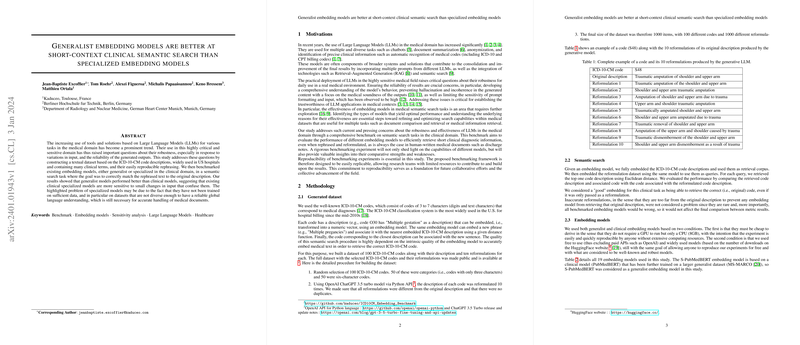Introduction
In the landscape of medical informatics, embedding models serve as fundamental tools in semantic search tasks—processes vital for the retrieval of clinical information from vast datasets. Such models convert text into numerical vectors, which can be compared to find the most similar pieces of content. A recent evaluation focused on a comparison between general LLMs and those specialized for clinical purposes, examining their performance in semantic search tasks using clinical diagnostic information from ICD-10-CM codes.
Methodology and Dataset
The ICD-10-CM codes, a cornerstone in U.S. hospital systems for coding diagnoses, provided the foundation for this paper. A dataset was generated consisting of 100 ICD-10-CM codes, each with a main description and ten reformulated phrases intended to simulate how varied wording can appear in genuine medical documents. LLM ChatGPT 3.5 turbo produced these rephrasings, deliberately diversifying from the original descriptions. The selected models underwent performance tests using these rephrasings as queries in a semantic search task to match them with the appropriate ICD-10-CM code description.
Two central conditions governed the choice of models: the requirement for CPU-only operability for widespread accessibility and cost-effectiveness, and the preference for free and commonly used models from established repositories.
Results
When the results came in, generalist models like jina-embeddings-v2-base-en outpaced their specialized counterparts by significant margins across exact and category matching and character error rate (CER) metrics. The leading generalist model exhibited an exact matching rate of 84.0%, starkly higher than the top-performing specialized model, ClinicalBERT, at 64.4%. Such outcomes paint a nuanced picture: while clinical embedding models are honed for medical terminology, it is the generalist models, with their exposure to a broader linguistic landscape, that demonstrate greater resilience against variations in clinical text.
Conclusion and Implications
The inference drawn from this head-to-head pits generalist models as more adept at the task of short-context clinical semantic search than their specialized analogs. The breadth of training data, including non-medical content, seems to endow these models with superior versatility to grasp nuanced language use as found in healthcare settings. The findings resonate with current dialogues on LLM utility in clinical applications, suggesting that for certain tasks, a robust general language understanding may be more valuable than specialized knowledge. With this new insight, future research may explore wider or deeper contexts, perhaps tapping into full-length medical documents or benchmarking against newer, more advanced models. The research affirms that the path to refining LLMs for medical use may well rely on their ability to navigate a diverse array of human language.
